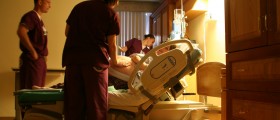Down Syndrome (Trisomy 21)
Down syndrome is a condition that delays both the physical and mental development of a child due to excess genetic material. 1 out of 800 babies is affected.
Prenatal Screening and Diagnosis
Down syndrome is diagnosed by two types of prenatal tests on a fetus, screening, and diagnostic tests. Screening tests calculate the DS risk chance in a fetus, while diagnostic tests can show if the fetus is affected by the condition. Screening tests are easy to perform and not expensive. Because they are inconclusive and can’t confirm the presence of the syndrome, they are used as initial tests. After seeing the chances, the parents can decide whether to do Diagnostic tests as well or not.
Diagnostic tests are used to detect chromosomal abnormalities including Down syndrome. They are close to 99% accurate. The problem is that they are done inside the uterus, and therefore increase the risk of birth complications or even miscarriage. Because of this, the diagnostic tests were advised only to women over 35, to those who had abnormal results on screening, and those with a history of a genetic defect in the family. Nowadays, the American College of Obstetrics and Gynaecology is recommending invasive Down syndrome diagnostic testing to all pregnant women.
It is recommended to contact a genetic counselor or the doctor, who will help with the choice and clear up all uncertainties by explaining the positive and negative sides of the test.
Respiratory disorders of Down syndrome
Breathing problems that accompany Down syndrome are usually the primary cause of disease and hospitalization, especially in small children. The problem is often underestimated and there are very few published studies on this subject. Due to this, Specialist investigation and treatment are not requested often.
Breathing problems affect increased sleep-related lower airways problems and upper airway obstruction. The underlying pathology of breathing problems is often multifactorial. They can cause lower airways problems contributory factors are hypotonia, immune dysfunction, Gastro-oesophageal reflux, cardiac disease, relative obesity, small lower air compression, large airway compression, tracheobronchomalacia, subpleural cysts and pulmonary hypoplasia.
In case of upper airway problems the contributing factors include increased secretion, relative glossoptosis, obesity, hypotonia, midface hypoplasia, nasal congestion, tonsils, adenoids, and small upper airway volume.
It is very important to diagnose the gastro-oesophageal reflux possibility in time, so it can be investigated and treated aggressively by an attempt to eradicate nasal congestion that includes trial cow’s milk-free diet, continuous intermittent antibiotics low dose and nuk decongester or mechanical decongestion. Chronic lower airway disease should also be treated aggressively by regular inhaled corticosteroids and continuous prophylactic antibiotics.
- Children with Down’s syndrome on average spend 2–3 times more time in hospital than those without Down’s syndrome
- In children with Down’s syndrome, up to the age of 18, RTIs are the second leading cause of death. It is therefore important that effective interventions to prevent and treat these infections are developed.
- A number of preventive interventions are commonly practiced and believed to be of benefit including use of prophylactic antibiotics, respiratory syncytial virus (RSV) prophylaxis for subgroups (eg, those with cardiac disease), additional immunizations and longer treatment courses. However, no previous systematic review has been undertaken to ascertain the evidence base.
- By a broad systematic search and review of the literature, we identified only 5 published studies on the management of RTIs in children with Down’s syndrome. This is remarkable in the light of the large body of literature in this field: Most high-quality studies on the management on RTIs in children have excluded this vulnerable group that are at high risk of these infections.
- We found that pidotimod, an immunostimulant, and palivizumab, a human monoclonal antibody, may have a role in preventing RTIs in children with Down’s syndrome with the latter particularly effective in young children (until 2 years of age) against RSV-RTI hospitalizations. Currently, the American Academy of Pediatrics recommends the use of palivizumab in children with Down’s syndrome who are at risk of severe RSV-related infections (eg, congenital heart disease, airway clearance issues, prematurity). Once published, the ongoing postmarketing observational study is likely to add to this evidence base. Oral zinc was not noted to be effective in preventing RTIs.


















Your thoughts on this
Loading...